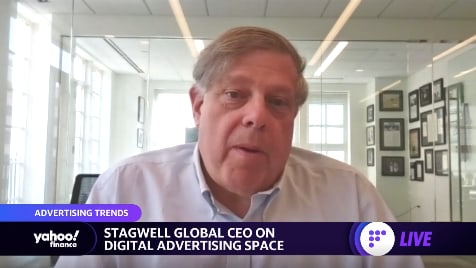Stagwell Global CEO Mark Penn joins Yahoo Finance Live to discuss the state of the advertising industry, TV versus digital advertising, and how marketers are responding to the potential ad-supported streaming tier from Netflix.
Video Transcript
[MUSIC PLAYING]
– Welcome back, everyone. Global advertising growth is expected to slow in 2022 to 9.2%, according to media investment and analysis firm Magna, as companies battle an economic slowdown and record inflation. Joining us now to discuss the future of the ad space is Stagwell Global CEO Mark Penn. Mark, good to have you here with us today. So put this in a broader context for us. What type of figures are we talking with these types of percentages declines that we’re looking across?
MARK PENN: Well, as you can see, advertising is still growing significantly. And particularly it’s very hard to read what advertising is these days, because there’s a tremendous shift from conventional and television advertising over to online advertising. And in the online market space now, you’ve got so many different options, including TikTok, the Amazon Marketplace, the Walmart Marketplace. And soon you’ll have Netflix.
So I think that what you’re seeing here is perhaps an overread of impact. You saw a strong jobs report. We think there’s going to be a relatively strong holiday season. There’s been a strong travel season here. So I don’t know what next year is going to be. But this year looks pretty good for marketing and advertising.
– How would things change, Mark, if we do slip into a recession this year?
MARK PENN: Well, look, usually I think if we slip into a recession, people trim their advertising somewhat. Some brands make the opposite decision. P&G is famous for gaining market share precisely during those periods. I think, though, that TV is the big loser. The push and the expansion of digital marketing, the need to address consumers directly, and the fact that most online marketing is performance oriented, I think that’s more insulated from a recession than typical brand, big event marketing will be, if there is such a recession.
– What type of reception do you believe, then, that a ad-supported tier that Netflix is considering offering and building up, what type of reception would that have among marketers?
MARK PENN: I think that’s going to get a very strong reception. I think the fact is that Netflix took a lot of eyeballs out of advertising space. And I think that fresh, addressable content like that is going to do really well in the marketplace, just as you’ve seen Amazon do really well with advertising as well. If you have people’s time, you can really get some advertising out of it. And certainly Netflix has people’s time.
– So, Mark, you have Netflix now moving towards an ad model. You have TikTok doing its thing, gobbling up market share. What does this all mean to Facebook?
MARK PENN: It means, I think, that you see some distribution here from Facebook, not– I think that if you look, the Amazon and the Walmart Marketplace probably give Google competition. TikTok gives Facebook competition. Netflix gives the networks competition.
From a Stagwell point of view, and we’re several billion dollar combined in digital marketing services, and we buy about $5 billion, mostly online, from our perspective, this expanded competition and multiplicity of choice to reach people is really quite good. It should, I think, lower prices. And that may lower margins for some of the tech companies, but not because advertising is contracting. It’s actually expanding.
– What do you believe this means for some of the media properties even that are online, whether they’re publishers, whether they’re news outlets and so forth, and where advertisers are going to really kind of base their own expenditures there? I mean, if I take BuzzFeed, for instance, the well-known creator of listicles who has done well and has seen advertisers flock to it in the past, I mean, this is now a publicly traded company that’s moved lower by 82% over the past year. And I question just broadly what an advertising pullback would mean to a company like that.
MARK PENN: Well, the biggest buzzword in advertising today is “performance,” right? And how do you measure that performance is becoming critically more important. And I think that when you look at it, there’s a multiplicity of choices. Then people are going to then say, OK, which is most effective?
I don’t know whether BuzzFeed advertising is less effective. Twitter has typically been less effective than Facebook over time. I think that publications and sites have to stand on effectiveness. And so if you have an incredible car section, you might have an incredible ability to reach car consumers that would be quite valuable. So the advertising value that publications have is going to be determined by the demand that there is in the marketplace for the consumers that they draw to those places.
– All right, I’ll leave it there for now. Stagwell Global CEO Mark Penn, good to see you again. Have a great weekend.
MARK PENN: Thank you.








